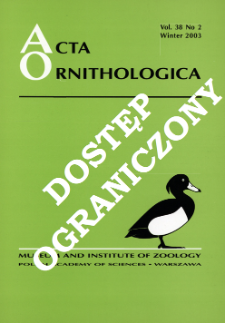
Obiekt
Tytuł: Song behaviour and range use in the polygamous aquatic warbler Acrocephalus paludicola
Twórca:
Schmidt, Veronika (1973– ) ; Schaefer, Heinrich Martin ; Leisler, Bernd
Data wydania/powstania:
Typ zasobu:
Inny tytuł:
Acta Ornithologica, vol. 34, no. 2 ; Etologia śpiewu i terytorializm poligamicznych samców wodniczki ; Aquatic warbler - song behaviour and range use
Współtwórca:
Polska Akademia Nauk. Muzeum i Instytut Zoologii ; Meeting of the European Ornithologists' Union (2 ; 1999 ; Gdańsk)
Wydawca:
Muzeum i Instytut Zoologii PAN
Miejsce wydania:
Opis:
Referat wygłoszony na Second Meeting of the European Ornithologists' Union ; Bibliogr. p. 212 ; P. [209]-213 ; 27 cm ; Abstract in Polish. Taxa in Latin
Typ obiektu:
Abstrakt:
Males Aquatic Warblers used three different song types. Playback experiments revealed, that A-type song had an intrasexual function, while C-type song seemed to serve intersexual communication. Song flight contained a higher portion of C-song than spontaneous song. Song flight rate was not constant throughout the breeding season with a maximum in the absence of receptive females. The range use of both sexes was studied using radio-telemetry during two breeding seasons. Males used home ranges of up to 8 ha in size. These home ranges overlapped up to 74% with the ranges of other males. Females used isolated patches of 2.8 to 6.4 ha within activity ranges of 100-160 ha during the mating period. Seasonal variation in mobility of males was correlated to the presence of receptive females. The diurnal mobility of males was constant during the day and decreased after 20:00 when males participated in an evening chorus.
Czasopismo/Seria/cykl:
Tom:
Zeszyt:
Strona pocz.:
Strona końc.:
Szczegółowy typ zasobu:
Format:
Identyfikator zasobu:
Źródło:
MiIZ PAN, call no. P.257, Vol. 34, No 2 ; MiIZ PAN, call no. P.4568, Vol. 34, No 2 ; kliknij tutaj, żeby przejść
Język:
Prawa:
Rights Reserved - Restricted Access
Zasady wykorzystania:
Digitalizacja:
Museum and Institute of Zoology of the Polish Academy of Sciences
Lokalizacja oryginału:
Library of the Museum and Institute of Zoology of the Polish Academy of Sciences
Dofinansowane ze środków:
Programme Innovative Economy, 2010-2014, Priority Axis 2. R&D infrastructure ; European Union. European Regional Development Fund
Dostęp:
Kolekcje, do których przypisany jest obiekt:
- Repozytorium Cyfrowe Instytutów Naukowych > Kolekcje Partnerów > Muzeum i Instytut Zoologii PAN > Czasopisma
- Repozytorium Cyfrowe Instytutów Naukowych > Kolekcje Partnerów > Muzeum i Instytut Zoologii PAN > Wydawnictwa MiIZ PAN > Acta Ornithologica
- Repozytorium Cyfrowe Instytutów Naukowych > Piśmiennictwo > Czasopisma/Artykuły
Data ostatniej modyfikacji:
2 paź 2020
Data dodania obiektu:
20 maj 2014
Liczba pobrań / odtworzeń:
64
Wszystkie dostępne wersje tego obiektu:
https://rcin.org.pl./publication/61253
Wyświetl opis w formacie RDF:
Wyświetl opis w formacie RDFa:
Wyświetl opis w formacie OAI-PMH:
| Nazwa wydania | Data |
|---|---|
| Song behaviour and range use in the polygamous aquatic warbler Acrocephalus paludicola / Schmidt, Veronika (1973- ) | 2 paź 2020 |
Obiekty Podobne
Kruszewicz, Andrzej (1959– ) Dyrcz, Andrzej (1933– )
Procházka, Petr (1976– )
Fertikova, Katherine
Dyrcz, Andrzej
Piotrowska, Małgorzata Wesołowski, Tomasz (1950– )
Surmacki, Adrian Stępniewski, Janusz Zduniak, Piotr
Dunajewski, Andrzej (1908–1944)
Nowakowski, Jacek J.

 INSTYTUT ARCHEOLOGII I ETNOLOGII POLSKIEJ AKADEMII NAUK
INSTYTUT ARCHEOLOGII I ETNOLOGII POLSKIEJ AKADEMII NAUK
 INSTYTUT BADAŃ LITERACKICH POLSKIEJ AKADEMII NAUK
INSTYTUT BADAŃ LITERACKICH POLSKIEJ AKADEMII NAUK
 INSTYTUT BADAWCZY LEŚNICTWA
INSTYTUT BADAWCZY LEŚNICTWA
 INSTYTUT BIOLOGII DOŚWIADCZALNEJ IM. MARCELEGO NENCKIEGO POLSKIEJ AKADEMII NAUK
INSTYTUT BIOLOGII DOŚWIADCZALNEJ IM. MARCELEGO NENCKIEGO POLSKIEJ AKADEMII NAUK
 INSTYTUT BIOLOGII SSAKÓW POLSKIEJ AKADEMII NAUK
INSTYTUT BIOLOGII SSAKÓW POLSKIEJ AKADEMII NAUK
 INSTYTUT CHEMII FIZYCZNEJ PAN
INSTYTUT CHEMII FIZYCZNEJ PAN
 INSTYTUT CHEMII ORGANICZNEJ PAN
INSTYTUT CHEMII ORGANICZNEJ PAN
 INSTYTUT FILOZOFII I SOCJOLOGII PAN
INSTYTUT FILOZOFII I SOCJOLOGII PAN
 INSTYTUT GEOGRAFII I PRZESTRZENNEGO ZAGOSPODAROWANIA PAN
INSTYTUT GEOGRAFII I PRZESTRZENNEGO ZAGOSPODAROWANIA PAN
 INSTYTUT HISTORII im. TADEUSZA MANTEUFFLA POLSKIEJ AKADEMII NAUK
INSTYTUT HISTORII im. TADEUSZA MANTEUFFLA POLSKIEJ AKADEMII NAUK
 INSTYTUT JĘZYKA POLSKIEGO POLSKIEJ AKADEMII NAUK
INSTYTUT JĘZYKA POLSKIEGO POLSKIEJ AKADEMII NAUK
 INSTYTUT MATEMATYCZNY PAN
INSTYTUT MATEMATYCZNY PAN
 INSTYTUT MEDYCYNY DOŚWIADCZALNEJ I KLINICZNEJ IM.MIROSŁAWA MOSSAKOWSKIEGO POLSKIEJ AKADEMII NAUK
INSTYTUT MEDYCYNY DOŚWIADCZALNEJ I KLINICZNEJ IM.MIROSŁAWA MOSSAKOWSKIEGO POLSKIEJ AKADEMII NAUK
 INSTYTUT PODSTAWOWYCH PROBLEMÓW TECHNIKI PAN
INSTYTUT PODSTAWOWYCH PROBLEMÓW TECHNIKI PAN
 INSTYTUT SLAWISTYKI PAN
INSTYTUT SLAWISTYKI PAN
 SIEĆ BADAWCZA ŁUKASIEWICZ - INSTYTUT TECHNOLOGII MATERIAŁÓW ELEKTRONICZNYCH
SIEĆ BADAWCZA ŁUKASIEWICZ - INSTYTUT TECHNOLOGII MATERIAŁÓW ELEKTRONICZNYCH
 MUZEUM I INSTYTUT ZOOLOGII POLSKIEJ AKADEMII NAUK
MUZEUM I INSTYTUT ZOOLOGII POLSKIEJ AKADEMII NAUK
 INSTYTUT BADAŃ SYSTEMOWYCH PAN
INSTYTUT BADAŃ SYSTEMOWYCH PAN
 INSTYTUT BOTANIKI IM. WŁADYSŁAWA SZAFERA POLSKIEJ AKADEMII NAUK
INSTYTUT BOTANIKI IM. WŁADYSŁAWA SZAFERA POLSKIEJ AKADEMII NAUK


































